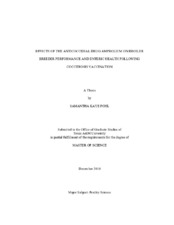| dc.contributor.advisor | Caldwell, David J. | |
| dc.creator | Pohl, Samantha Kaye | |
| dc.date.accessioned | 2012-02-14T22:18:06Z | |
| dc.date.accessioned | 2012-02-16T16:13:29Z | |
| dc.date.available | 2012-02-14T22:18:06Z | |
| dc.date.available | 2012-02-16T16:13:29Z | |
| dc.date.created | 2010-12 | |
| dc.date.issued | 2012-02-14 | |
| dc.date.submitted | December 2010 | |
| dc.identifier.uri | https://hdl.handle.net/1969.1/ETD-TAMU-2010-12-8647 | |
| dc.description.abstract | Two experiments were performed to evaluate effects of amprolium administration at specific times and concentrations in replacement broiler breeders of three genetic lines vaccinated against coccidiosis. Effects on performance parameters including body weight and flock uniformity, and post-vaccination oocyst cycling patterns were evaluated in addition to development of immunity following clinical Eimeria challenge according to gross and microscopic lesion scoring, post-challenge body weight gain (BWG), and total oocyst output. Experiment one was conducted on fresh pine shavings while experiment two was conducted on used litter remaining in treatment pens from the first trial.
No significant differences were seen among treatment groups with regard to body weight in either trial. Increased magnitude of oocyst shedding was observed in trial one, Line A with the group receiving amprolium on day 10. Trends in the data indicated increased uniformity in Line A related to amprolium administration following day 21. The group in Line A receiving amprolium at day 10 showed a significantly lower degree of total oocyst output following challenge than the other medicated groups. The group receiving amprolium on day 10 in Line B showed significant reduction in post-vaccination oocyst shedding following treatment in both trials while all shedding was delayed in trial two when compared to the first trial. Effects on uniformity in Line B pullets varied between trials with trends indicating it being advantageous when used litter was a factor. Higher post-challenge BWG was observed in Line B pullets administered the low concentration at day 16 than the controls. Reductions in gross lesion development were seen in Line B pullets in both trials. Line C pullets receiving the highest concentration of amprolium at day 16 showed significantly less uniformity in trial one while the controls appeared to perform better than all medicated groups in trial two. All medicated groups in Line C exhibited delayed and increased magnitudes of oocyst shedding in trial two. These data indicate that the effects of amprolium on performance and immunity development are variable according to genetic strain and indicated that administration may be influenced by litter condition. | en |
| dc.format.mimetype | application/pdf | |
| dc.language.iso | en_US | |
| dc.subject | Poultry | en |
| dc.subject | broiler breeder | en |
| dc.subject | coccidiosis | en |
| dc.subject | vaccination | en |
| dc.subject | amprolium | en |
| dc.title | Effects of the Anticoccidial Drug Amprolium on Broiler Breeder Performance and Enteric Health Following Coccidiosis Vaccination | en |
| dc.type | Thesis | en |
| thesis.degree.department | Poultry Science | en |
| thesis.degree.discipline | Poultry Science | en |
| thesis.degree.grantor | Texas A&M University | en |
| thesis.degree.name | Master of Science | en |
| thesis.degree.level | Masters | en |
| dc.contributor.committeeMember | Lee, Jason T. | |
| dc.contributor.committeeMember | Byrd, James A. | |
| dc.contributor.committeeMember | Linares, Jose | |
| dc.type.genre | thesis | en |
| dc.type.material | text | en |


